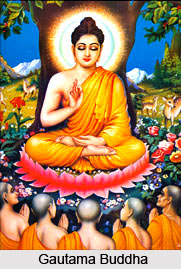 The Pali or Sanskrit word "Sangha" connotes "assembly" or "association" that has common vision, goal, or purpose. Sangha is the last of the three Refuges of Buddhism. In its primary sense this means the Arya-Sangha, or Assembly of the Elect. It consists of all those who have succeeded in traversing at least that stage of the Path whence retrogression into the Round for more than seven karma-resultant births is impossible. Such are the Stream-Entrants, the Once-Returners, the Non-Returners, the Arhants, and the Bodhisattvas.
The Pali or Sanskrit word "Sangha" connotes "assembly" or "association" that has common vision, goal, or purpose. Sangha is the last of the three Refuges of Buddhism. In its primary sense this means the Arya-Sangha, or Assembly of the Elect. It consists of all those who have succeeded in traversing at least that stage of the Path whence retrogression into the Round for more than seven karma-resultant births is impossible. Such are the Stream-Entrants, the Once-Returners, the Non-Returners, the Arhants, and the Bodhisattvas.
Lord Buddha is symbolised by the sacred icon and the Dharma by the handwritten or printed volumes of the Scriptures and the Arya Sangha is re¬presented, for practical purposes, by the Bhikshu-Sangha or Order of Monks. This great institution with the possible exception of its Jain counter¬part is the oldest surviving religious order in the world. It came into existence within a few months of the Buddha"s Enlightenment. It consisted of those of the Buddha"s followers who, having re¬nounced the household life, devote the whole of their time and all their energies to the realization of Nirvana.
Like the Dharma, the Sangha passed through various stages of development. At first, during the early lifetime of the Founder, the Sakyapntra sramanas, as they were called, remained out¬wardly indistinguishable from the other religious fraternities of the time. What in fact set them apart was the special Dharma they professed. They, too, were of philanthropic and hermitic habit, assembled twice a month on the days of the full moon and new moon, were of fixed residence during the rains, and so on. The second period of development may have started before the Parinirvana. It saw the compilation of a Rule of 150 articles known as the "Pratimoksha", the recitation of which replaced the original chanting of Dharma-stanzas at the fortnightly assemblies. Finally, the Sangha became coenobitical, whereupon the primitive undivided "Bhikshu-Sangha of the Four Quarters" split up into a number of virtually autonomous local communities, and the Pratimoksha had to be supplemented by the Skandhakas or complete insti¬tutes of coenobitical monasticism. All these developments occurred within the space of about two centuries. Pratimoksha and Skandhakas together con¬stitute the Vinaya, a term originally connoting simply the practical or dis¬ciplinary aspect of the Dharma.
Parallel with the Bhikshu-Sangha a "Bhikshuni-Sangha" or Order of Nuns was also developed. Though according to the tradition the Buddha was reluctant to allow women to go forth into the homeless life but in the history of Indian Buddhism, the "Bhikshuni-Sangha" plays an insignificant part. In a more general sense the Sangha comprises the entire Buddhist com¬munity, sanctified and unsanctified, the professed religious and the lay de¬votees, men and women. As such it is sometimes known as the Mahasangha or "Great Assembly". Lay devotees (upasakas and upasikas) are those who go for refuge to the Three Jewels, worship the relics of the Buddha, observe the Five Precepts of ethical behaviour, and support the monks.
The growth of coenobitical monasticism naturally encouraged the de¬velopment within the Sangha of different regional traditions. After being consolidated into distinct versions of the Dharma, the regional traditions eventually emerged as independent sects. Thus a century or more after the Parinirvana tensions arose between the monks of the east and the monks of the west; and the Mahasanghikas, who were more sympathetic to the spiritual needs of the laity, splintered from the Sthaviravadins (more commonly known as Theravddins, the Pali form of the name). They tended to interpret the Dharma in exclusively monastic terms. This was the first formal schism within the Sangha. During the century that followed the Sthaviravadins subdivided twice. First the schism of the Pudgalavadins was introduced, who believed in the existence of the person as a real absolute fact. Later the schism of the Sarvastivadins appeared with the assertion of the real existence of the ultimate elements of experience (dharma) throughout the three periods of time. In this way there had arisen, by the time of Ashoka, four independent monastic corporations, each with its own centres, its own ordination-lineage, its own orally transmitted version of the Dharma, its own distinctive tenets, and its own peculiarities of outward observance. Together with their respective sub-divisions, the four make up the so-called "Eighteen Sects" (actually there were many more) of early Buddhism.
On the mundane level, the polarity of the Sangha and the layfolk represents a socio-ecclesiastical rather than a spiritual division and all followers of the Buddha are united through their common devotion to the Bodhisattva ideal. Faith, as a means of attaining Enlightenment, ranks co-ordinate with Wisdom. The Buddha is regarded not only as an enlightened being but also as the embodiment of the Truth and Reality behind the universe. Besides being endowed with three Bodies (trikaya), the Dharmakaya or Body of Truth, the Sambhogakaya or Body of Reciprocal Enjoyment, and the Nirmanakaya or Created Body, corresponding to the absolute, the celestial, and the mundane planes of existence, he has various forms and attributes. These are the different Buddhas and Bodhisattvas, such as Amitabha, the Buddha of Infinite Light, and Manjusri, Avalokitesvara, and Vajrapani, the Bodhisattvas of Wisdom, Compassion, and Power respectively, around each of whom there centres a popular cult.
In contradistinction to the Mahayana, "The Great Vehicle", the seeds of which were transmitted by the Mahasanghikas and their offshoots, all the other sects, but especially the Sarvastivadins, were retrospectively designated the Hinayana, "The Inferior Vehicle".









